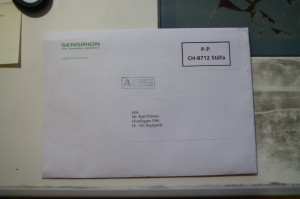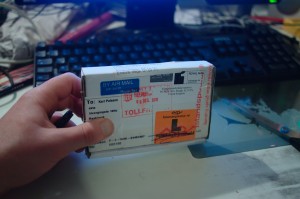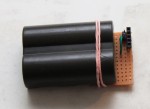Following on from yesterday’s post about Microchip’s samples packaging, today we have Sensiron. No handling charges, so no risk of any VAT charges from customs nazis here. And delightfully, the samples came just in a regular business envelope, inside a little sleeve of bubble wrap. This was just happily posted through the letterbox like any other mail, instead of being held by the aforementioned customs nazis for a few days while they searched for a receipt to bill VAT from. WIN!
Category Archives: hardware
Packaging samples and small orders: Sensiron
Packaging samples and small orders: Microchip
I’ve gotten a few samples from various companies over the years, or in various cases, bought a couple of parts direct from the manufacturer. It often amuses me the huge differences in packaging levels between the various manufacturers. I’ve got a few things recently, while looking for some particular parts, so I thought I’d run a short series on how some companies stack up.
Microchip sent me four SOT23 devices in this nice small cardboard box below. This is fine, and I might even find a use for the box again, but because it came in a box, customs here in Iceland held it up for a few days searching for a receipt. (first from me, and then inside the parcel when I couldn’t provide one) On the bright side, the parts list inside the box didn’t list the “handling” charge they charge for all samples, so customs didn’t try and charge me VAT. Small miracles :)
A simple envelope with maybe a sleeve of bubbles would have been plenty, but this is fine really. Nothing to complain about :)
Back in action… power meters and sensor probes.
So, after a six month break or so, and a 700meg database of sensor data I wasn’t actually looking at, I’m back in action!
I finally bit the bullet, bought a commercial power meter, and finished off my power meter project. It’s based on: Open Energy Monitor v3 but mine is in regular C, instead of arduinoC, because that fits in better with the common code for the rest of my nodes. (Not all my nodes are arduino compatible hardware) Calibrating was a bit of a pain, but it’s working! Now to get it boxed up and attached somewhere a bit more useful. It’s currently tying up my only spare AVR chip, so it’s not live.
What else? I bought some sexy radio boards from Dresden Elektronik that look pretty neat. Basically combining an AVR with an xbee, in a smaller package, for the same price. Why did I ever actually get into xbees? I should have done more research on the available radio options :) If I wanted just radios, I should have looked at these MRF24740 radios from Microchip I’ve got some on their way, but haven’t tried them out yet.
One problem with both the xbees and the dresden boards is that they’re on 2mm and 1.27mm pitch pin headers. This is nice and compact, but not very friendly for breadboards :)
Which brings me to customer service! Dresden actually phoned me up about 2 weeks after I bought the boards to check how I was going, and if there was any engineering help they could give me! Awesome! Pity Icelandic customs had only finally released the modules to me the day before, and I’d only just realised just how fine pitch 1.27mm really was :) Again, I should have read a bit more first.
Still on customer service, I ordered some pin headers from Samtec Seems 23pin female sockets, 1.27mm pitch are not something that mouser/farnell/RS stock, but Samtec is actually one of those lovely manufacturers who ship small quantities direct, worldwide, for reasonable prices! Excellent! So excellent in fact, that they shipped out the 1.27mm sockets as soon as they were ready, and the 2mm ones (for more xbee based boards) two days later. So I get two _enormous_ toblerone packages (triangle tube, about 13-14cm/side, 90-100cm long?) Delivered separately, with 20 rather teensy tiny little sockets all up. I’m sure if I was in a hurry this would have been excellent, but it felt a little excessive really :)
But socket headers are not going to help on a breadboard, it’s still fine pitch. So I’m also back into PCB design again, something I haven’t done since uni.
Lots of excitement. Oh yeah, and software too of course. I mentioned at the start that I wasn’t really looking at any of the data. Well, now, I am and also in other ways making more use of the fact that I was uploading all this data to pachube for so long!
It’s good to be back, but it has meant I’ve been spending far too much time in front of the computer again :)
BP-511 breadboard adaptor, reusing nice batteries for my own needs
When I upgraded my camera due to the death of my dear beloved Canon 300D, I was left with a handful of BP-511 batteries, 1200mAh and up, with a nice charger. Except, they don’t really plug into anything very well. With a growing proliferation of small battery powered nodes around the house, I thought I should be able to reuse these. I’m probably burning some extra power by running these 7.5V batteries down to 3.3V, but I’m cool with that. Any production boards would be running on 2-3 AAs anyway, with a “proper” connector. But this is still pretty handy.
I just put some loops of bare copper wire on some strip board to make contacts, and then put in some headers to make it easier to connect to things. Presto!
- BP-511 breadboard adaptor
- BP-511 on bread board adaptor



